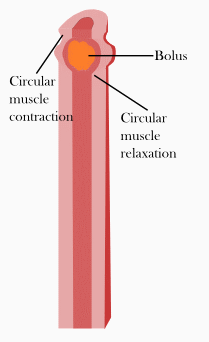The digestive system has a complex system of food movement and the regulation of secretion regulation, which are vital for its proper function. Movement and secretion are regulated by both long reflexes from the central nervous system (CNS), short reflexes from the enteric nervous system (ENS), and reflexes from gastrointestinal system (GI) peptides working in harmony with each other. In addition, there are three overarching reflexes that control the movement, digestion, and defecation of food and food waste: the enterogastric reflex, the gastrocolic reflex, and the gastroileal reflex.
Long and Short Reflexes
Long reflexes to the digestive system involve a sensory neuron sending information to the brain. This sensory information can come from within the digestive system, or from outside the body in the form of emotional response, danger, or a reaction to food. These alternative sensory responses from outside the digestive system are also known as feedforward reflexes. Emotional responses can also trigger GI responses such as the "butterflies in the stomach" feeling when nervous.
Control of the digestive system is also maintained by enteric nervous system (ENS), which can be thought of as a digestive brain that helps to regulate motility, secretion and growth. The enteric nervous system can act as a fast, internal response to digestive stimuli. When this occurs, it is called a short reflex.
Three Main Types of Gastrointestinal Reflex: Enterogastric, Gastrocolic, and Gastroileal
The enterogastric reflex is stimulated by the presence of acid levels in the duodenum at a pH of 3-4 or in the stomach at a pH of 1.5. When this reflex is stimulated, the release of gastrin from G-cells in the antrum of the stomach is shut off. In turn, this inhibits gastric motility and secretion of gastric acid (HCl). Enterogastric reflex activation causes decreased motility.
The gastrocolic reflex is the physiological reflex controlling the motility, or peristalsis, of the gastrointestinal tract. It involves an increase in motility of the colon in response to stretch in the stomach and byproducts of digestion in the small intestine. Thus, this reflex is responsible for the urge to defecate following a meal. The small intestine also shows a similar motility response. The gastrocolic reflex also helps make room for food in the stomach.
The gastroileal reflex is a third type of gastrointestinal reflex. It works with the gastrocolic reflex to stimulate the urge to defecate. This urge is stimulated by the opening of the ileocecal valve and moving digested contents from the ileum of the small intestine into the colon for compaction.

Peristalis
The gastrocolic reflex is one of a number of physiological reflexes controlling the motility, or peristalsis, of the gastrointestinal tract.
GI Peptides That Contribute to Gastrointestinal Signals
GI peptides are signal molecules that are released into the blood by the GI cells themselves. They act on a variety of tissues including the brain, digestive accessory organs, and the GI tract. The effects range from excitatory or inhibitory effects on motility and secretion, to feelings of satiety or hunger when acting on the brain. These hormones fall into three major categories: the gastrin family, the secretin family, and a third family composed of the remaining hormones that fit into neither of the these two families.